Continuing yesterday’s “big picture” theme of our trip to Belgium, today we talk about Belgian food.
Belgians take their food seriously. It is said that Belgians serve food with the quantity of Germany and the quality of France, and I found no evidence to contradict that. Throughout every Belgian city, from the largest tourist Mecca to the smallest village, are streets lined with restaurants and cafes and eateries and chocolaterias and every other sort of venue to stuff your face. Most of these restaurants have expansive outdoor patios in front of them, so that the typical Belgian avenue is populated not with parked cars or loitering tourists, but restaurant patrons eating bread or frites and drinking Trappist beers.

Clearly I’m not equipped to go into the finer points of Belgian cuisine, so instead I shall simply make a number of sweeping, almost certainly incorrect, generalizations based on my time there.

Belgian dining is based on four main elements.
The first is bread.
Whereas in America bread comes in at most two varieties (sliced or foreign), in Belgium there’s a damn-near-infinite selection of it. Bread comes in loaves or slices or rolls; it can be white or black or brown or mottled like sea coral; it can be smooth or crunchy or rich or smoky; it can be sweet or sour or starchy; and all these different varieties are usually on the table at any given meal. In the United States, “bread and water” is considered a prisoner’s rations; in Belgium, it’s an entire meal. Seriously. Every menu I read had something called the brood plaat or plat de pain — that is, the “bread plate,” and entire meal consisting of nothing but different types of bread. Bread is so fundamental to Belgium eating that it’s actually sold in outdoor automated vending machines, which outnumber any other vending machine by at least 2-to-1.
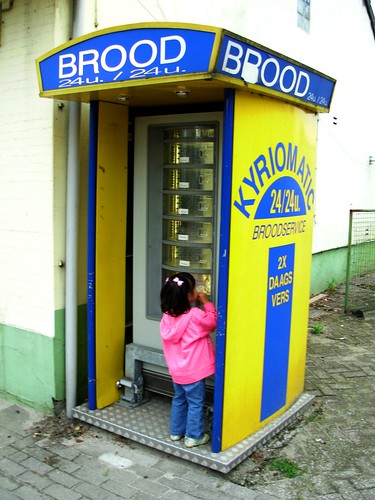
The next key element: frites, better known to Americans as french fries. Really, I shit you not.
Frites — which, together with burgers, form the basis of American fast (fat?) food — are huge in Belgium, which somewhat paradoxically is known for its gourmet tendencies. Of course, across the pond frites are not served as side dishes, but rather as an entree itself.* They arrive steaming hot in a bowl or a cone, covered in a dollop of mayonnaise**, curry mustard, tartar sauce, or other similarly yellowish goop. (Ketchup is a taboo reserved only for tacky Americans, apparently.)

* The one exception to this rule is mussels and frites, in which the fries share top billing with a simmering pot of steamed gastropods. Apparently mussels and frites is something of a Flanders delicacy, and so I felt compelled to try a little on general principle. They ain’t bad, but I’m still a fan of big ol’ burger, myself.

** Yes, just like Vincent says in Pulp Fiction, Europeans smother fries in mayonnaise, which got me thinking about that other Pulp-Fiction-authenticated European fast-foodism: that at McDonald’s the “Quarter Pounder” is renamed the “Royal,” on the grounds that “they got the metric system, they wouldn’t know what the fuck a Quarter Pounder is.” Is that true? Well, yes. Yes, it is:
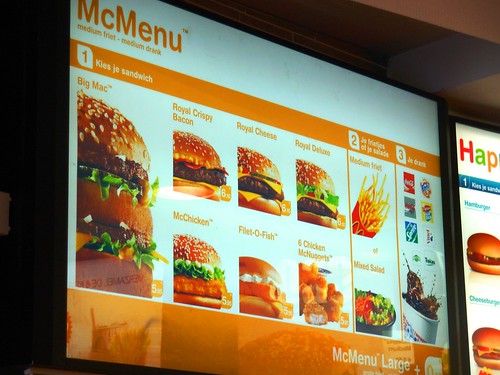
You can’t throw a brick in Belgium without hitting a frituur stand or two. They’re like the European analog of Starbucks — they’re everywhere, frequently on every corner of a given intersection. Couple the omnipresence of fried potato treats with their aforementioned love affair with bread, and it is clear that Belgians do not fear carbohydrates.
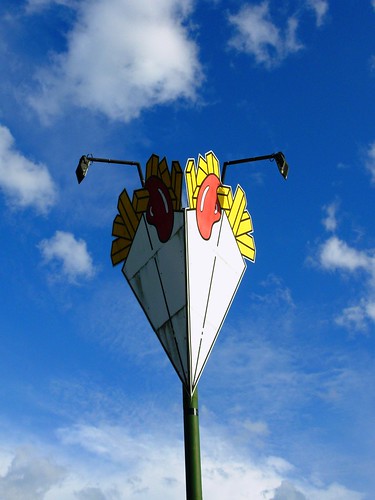
The third pillar on which Belgian dining rests is chocolate. Belgians are known far and wide for their chocolatering, and evidence of it can be found everywhere in the country. Whilst chocolate shops are not to be found on every corner in Belgium (that’s where the friterias are, after all), there’s still at least one per block. Inside any one of these places is a saccharine wonderland sure to delight both the imagination of young children and the wallets of their dentists: walls covered floor to ceiling with tins of fudges and chocolates and taffies and other various confections. You can get chocolate bars and chocolate nuggets, chocolate bricks and chocolate lollipops. They make chocolate statues and chocolate toys, chocolate girls and chocolate boys.* One can easily get Type-2 diabetes by simply walking into one of these places.

* They also make a lot of chocolate porn. Chocolate boobs and chocolate asses, chocolate phalluses and chocolate… er… lasses. It’s like Willy Wonka meets Rule 34.

Of course, the fourth and final primary component of Belgian feasting, the bedrock on which the whole edifice of their cuisine is built, is beer. Sweet, sweet beer.

The variety of Belgian beer is incredible, from lovely wheat beers, rich brown ales, sweet light blonds, to tart fruity meads. Just about the only thing their multiplicity of booze have in common is that they are invariably, heavenly delicious. Indeed, there are a number of Bavarian and Trappist monasteries throughout Belgium, so it is a place where the drink is quite literally touched by the hand of God.

Actually, another thing in common amongst Belgian beers is that they’re packed with alcohol: it makes up a whopping 11% of a Kasteel, while a “light” beer like a Leffe Blond racks up only 8%. Consequently, it usually only takes a sip or two before one finds themselves wrapped in a warm blanket of peaceful, if somewhat tipsy, happiness.

A peculiar quirk in Belgium is that each beer has assigned to it a unique glass specifically crafted to optimize the experience of drinking that particular beer by maximizing its bouquet, optimizing its foamy head, properly maintaining its serving temperature, emphasizing its particular kaleidoscope of colors, accentuating its various flavors, or just looking bad ass.

For example, a Leffe is traditionally served in a thick but humble goblet,

whereas a Tripel Karmeliet comes in an delicate glass tulip adorned with etched fleur-de-lys at its base and along its stem.

The somewhat bitter De Koninck comes in chunky, bucket-like snifter

while the deliciously sweet Tripel Karmeleit comes in a shimmering, golden grail.

The similarly sounding Chimay and Ciney are both served in silver-lined goblets, but the Chimay glass has an “hour-glass” taper above its stem
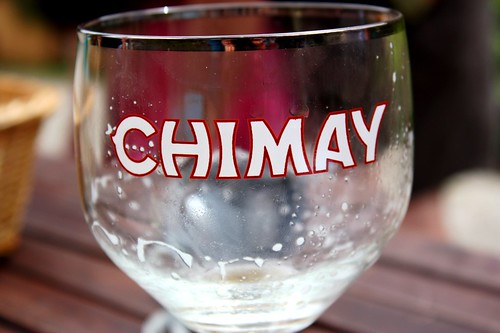
while the Ciney glass is, well, more “beer belly” in shape.

The light wheat beer Hoogarten comes in a beveled (but otherwise nondescript) miniature pint glass

while the dark brown Trappist Kasteel is served in an ornate, squat chalice with gold trim a miniature castle glass-blown into the base of its stem.

… and so on and on and on…
I did my best to sample a new beer* at each stop largely to experience new tastes, but also to see what cool glass it might be served in. (The winner, hands down, is the Pauwel Kwak, which is served in a tall swoopy “stirrup cup” with a rounded base, making it impossible to set the glass down on a table without capsizing it. The cup is always served with a small wooden stand to hold the glass upright; however, at 8.5% alcohol, getting the glass back in that little stand is a feat of ever-increasing dexterity as the drink goes on.)

* In fact, over the course of our stay I realized that it was much simpler to order beer than any other type of beverage, since (a) any beer one was likely to be served was infallibly exquisite and (b) was usually never more expensive than a Coke or a coffee (and sometimes less so).** The Queen B, on the other hand, is fond of ordering a lemonade, which is apparently a strange and unheard-of concept in Europe, and her attempts to order one variously produced Sprite, Fanta Orange, Fanta Lemon, Lem’Oh! (a flat, citrus drink), Lemonata (a fizzy lemony beverage), Bitter Lemon, Lemon Juice, Sparking Water, and a glass of tap water with a lemon floating dejectedly in it.
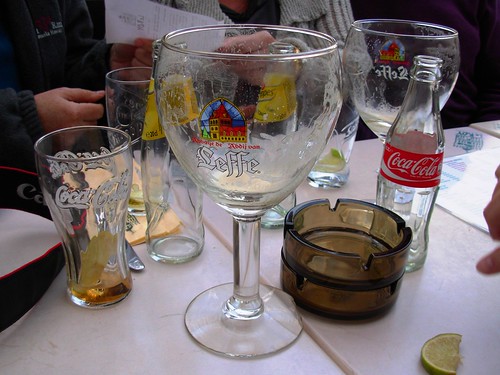
** The only downside to massive quantities of fine beer and cheap prices: in Europe, you have to pay to use the restrooms, anywhere from 20 to 70 cents per pee. It’s a helluva racket they got going there.

Not only is drinking a beer from the wrong kind of glass detrimental to its overall aesthetic experience, but it is considered to be of such appallingly poor taste that the offender is likely to be shunned from the public’s eye and, in extreme cases, shot through the liver.
So that’s a cursory overview, but there’s nothing like sampling the real thing. Proost!
